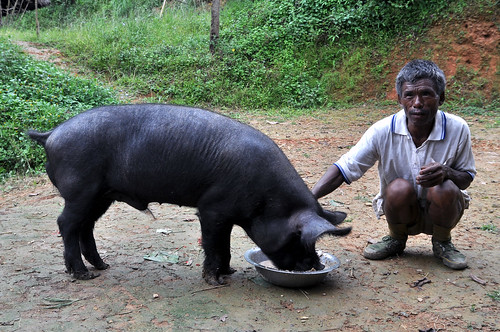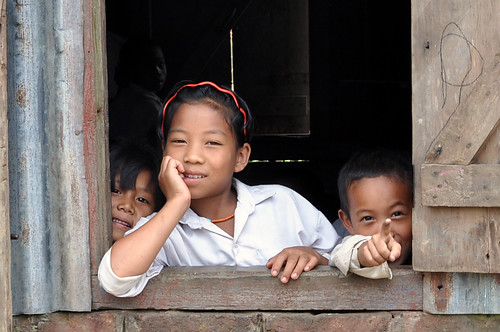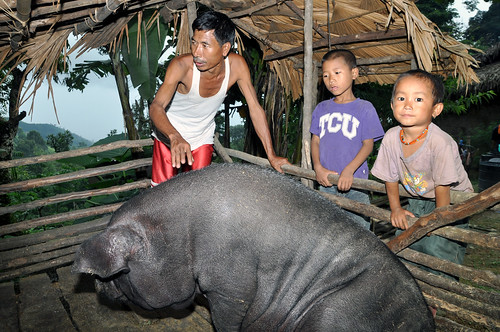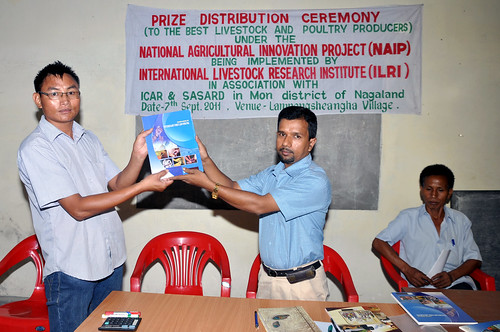
A crop and livestock farmer in Uttarakhand, India. Integrated crop and livestock farming systems can play a significant role in improving global food security (photo credit: ILRI/Susan Macmillan).
Gita Fartiyal is a master’s student at Almora University, in Uttarakhand, India. She is also a small-scale livestock keeper. The money she makes from selling milk and animals is helping pay for her schooling. Fartiyal and her brother keep about 40 goats on a family crop-and-livestock farm in the mid-Himalayan region of northern India. Gebremicheal Desta grows crops and keeps dairy cows on a small farm in Ethiopia’s’s northern region of Tigray. His family depends on the income it gets from farming to pay for food, daily expenses and school fees.
Smallholder farmers, especially those in mixed crop and livestock systems like Fartiyal and Desta, produce milk, meat and eggs not only for their families but also to meet growing demands for foods of livestock origin. In much of the developing world, increasing population, economic growth and urbanization is driving a rapid demand for livestock foods. In India, for example, smallholders are producing more milk (105 million tons of milk in 2009 compared to 74 million tons in 1999) to respond to an increasing demand for dairy products. With the world’s population expected to reach 9 billion people by 2050, smallholder farmers are expected to play an important role in meeting global food demand in coming years.
Mixed crop and livestock farming systems support nearly 1 billion poor people across the world. Most of these are smallholders working a couple of hectares and relying on family labour to grow crops and keep livestock. But questions remain about how best to intensify production in these mixed systems so as to increase food yields and do so sustainably.
A report released last year, ‘Integrating crops and livestock in subtropical agricultural systems’, produced by researchers from the International Livestock Research Institute (ILRI) and the International Maize and Wheat Improvement Center, evaluates options to sustainably intensify production in these smallholder mixed systems. The 2011 report explores ways of refining the integration of crop growing and animal husbandry in the face of ever-diminishing land and water resources and climate change.
‘We need to help these small-scale farmers make the most efficient use of their land and water resources to increase productivity while at the same time sustaining and enhancing their natural resource base’, said Iain Wright, a science leader at ILRI and one of the report’s authors.
According to the paper, a key to global food security is helping tropical smallholders produce more food more efficiently through smart integration of their crop and livestock production.
The authors recommend three practical ways to both improve and sustain smallholder crop production.
First, crop and animal scientists should work together in crop improvement programs to improve the fodder quality of cereal and legume food crops. The resulting new varieties of sorghum and other crops would provide good yields of both human food and livestock feed. Second, farmers should make greater use of crop residues as animal feeds, which will make better use of water resources by ‘spreading the “cost” of the water used for growing crops across the grain and animal feed components’. Third, farmers should more effectively harness manure for crop production by adopting the ‘technology of storing and distributing manure to avoid the loss of nutrients and biomass’.
In the battle to produce more food to feed the world, smallholder mixed crop and livestock systems are increasingly seen as competitive because they make efficient use of natural resources, spread risk across several enterprises and allow for more flexible and profitable use of family labour, all of which can translate into much lower costs and environmental impacts in producing food compared to large specialized and industrialized farms. The increasing demand for livestock products is also making it possible for farmers to access local markets and increase their incomes.
The report also acknowledges that mixed crop and livestock farming systems alone will not produce all the food the world will need. ‘Specialised cropping systems and intensive livestock systems will [also] play their part’, the paper says. The rapid transition to industrial production of poultry, pig and dairy production systems in Asia is an example of how intensified agricultural production systems are helping to meet food demands for growing populations in that part of the world.
At the same time, the vast army of small-scale farmers like Fartiyal and Desta will be able to fulfill their potential and fully participate in more efficiently integrated agricultural systems that improve global food security only if they have access to ‘appropriate technologies, supportive policies at local, national and regional level and dynamic markets that can supply inputs and channel outputs to consumers more efficiently’.
Download the report: https://cgspace.cgiar.org/handle/10568/5556
Watch a related ILRI photofilm: ‘A tribute to the unsung heroes of small-scale food production’, http://blip.tv/ilri-photofilm/tribute-to-the-unsung-heroes-of-small-scale-food-production-5225764





